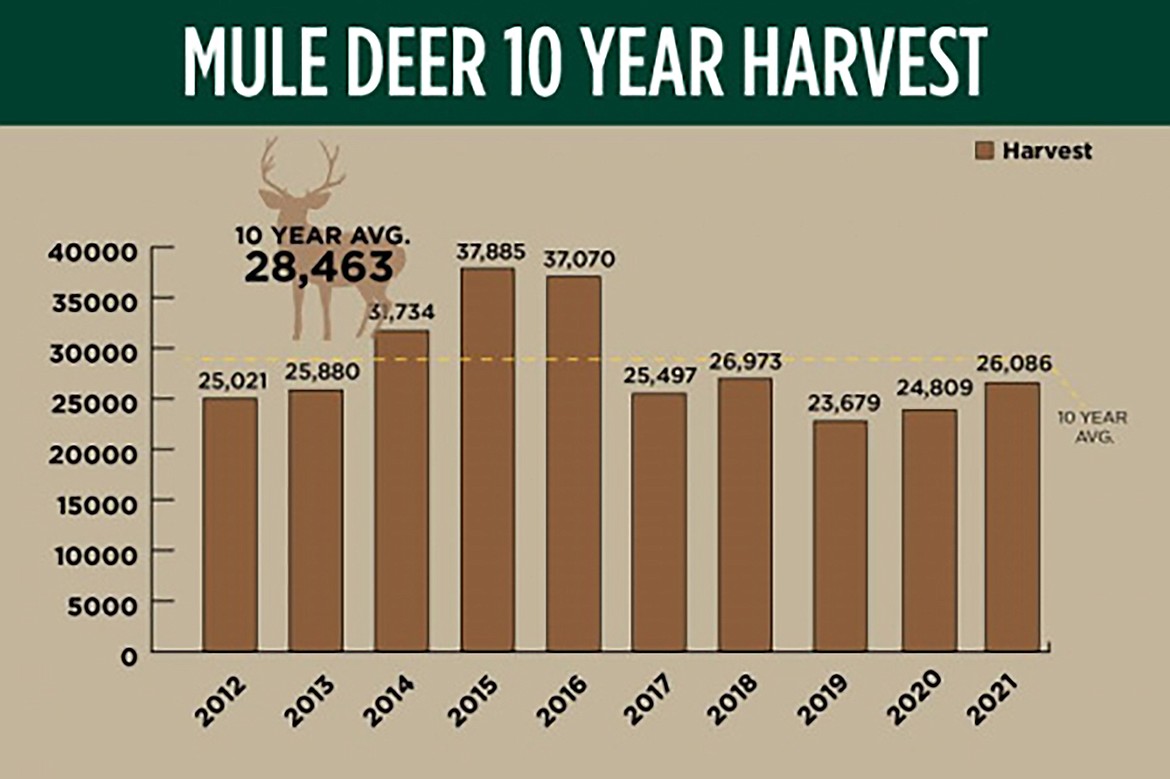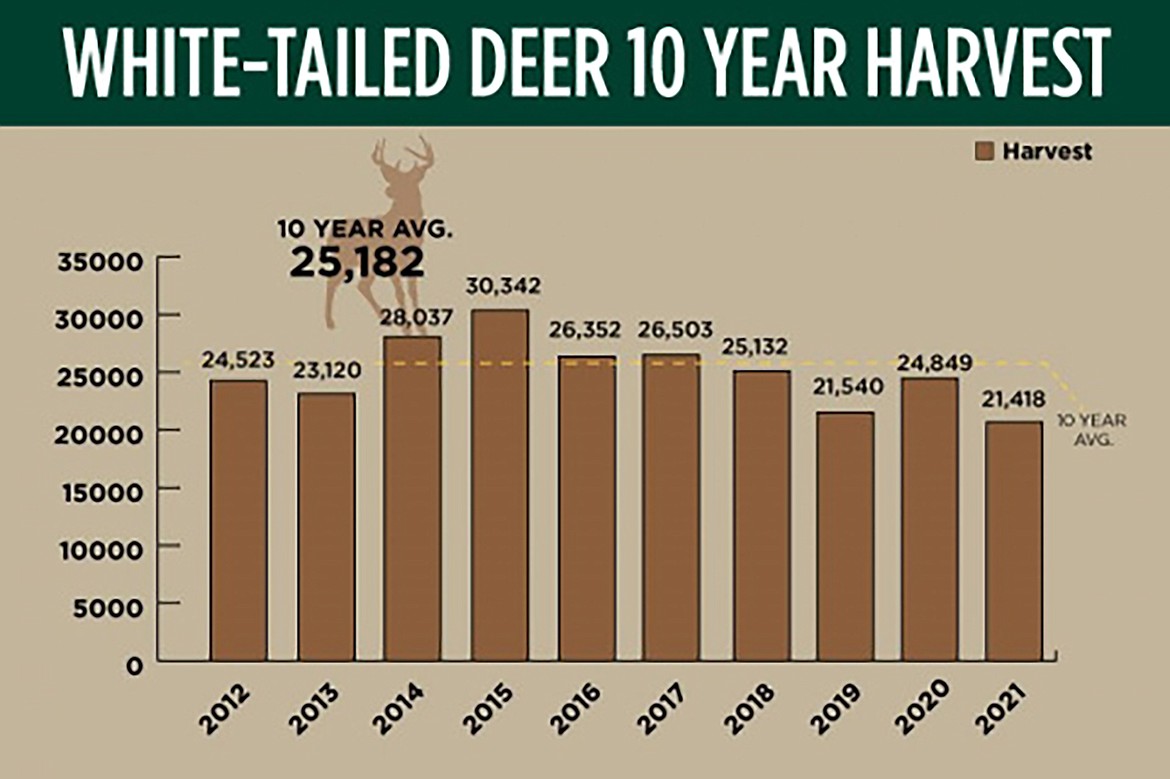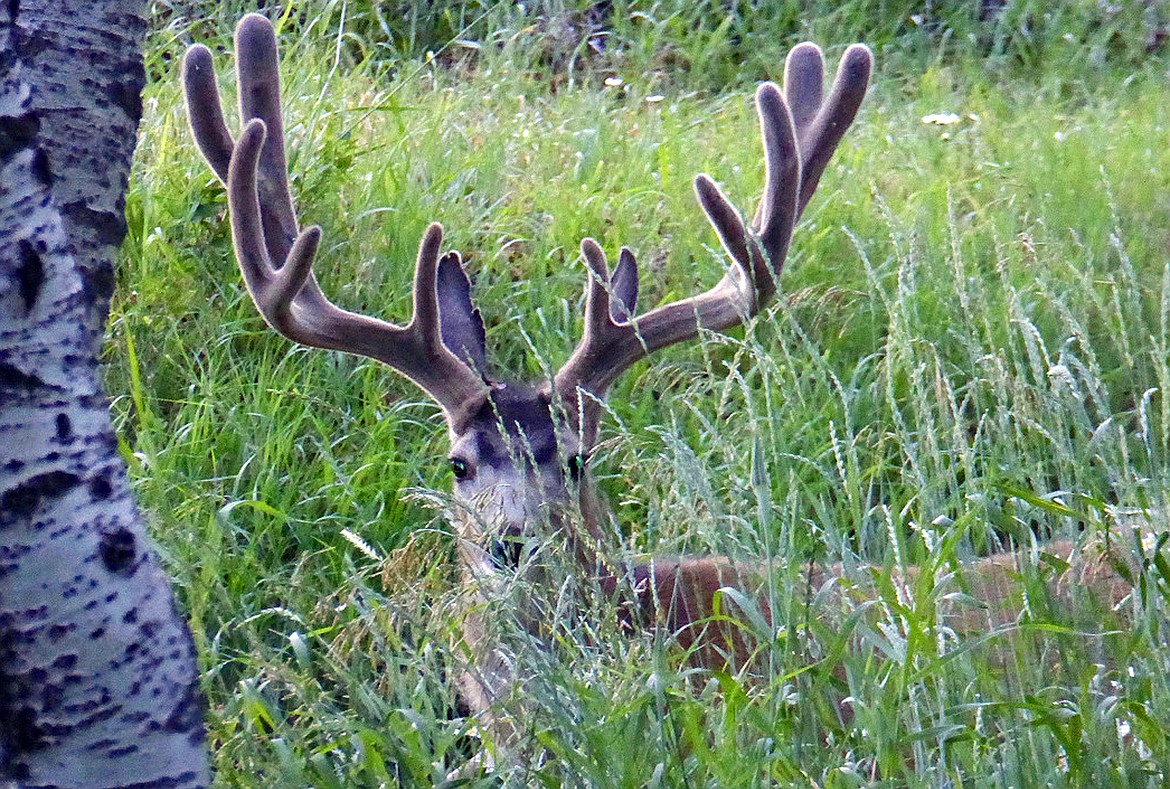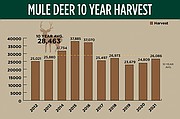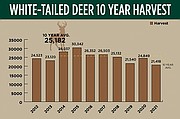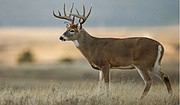Deer hunters have reason for optimism, caution
Deer hunters have reason for optimism and caution heading into the fall hunting season that opens Oct. 10 in most units for general, any-weapon hunts. There's some modest growth in mule deer herds, which will likely be reflected in the harvest. But white-tailed deer hunting in portions of the Clearwater area are unlikely to have recovered from a disease die-off last year, and chronic wasting disease was detected for the first time ever in Idaho last year, and the disease will have to be managed.
Hunters should beware of regulations this year regarding mandatory CWD testing and restrictions for transporting intact carcasses of deer, elk or moose taken in Units 14 and 15. To learn more about special rules, go to "What hunters in Units 14-15 need to know about CWD management this fall."
Mule deer herds continue to trend in the right direction after a tough winter in 2016-17 that led to a 30 percent decline in harvest in 2017, then another tough winter in 2018-19.
The drastic harvest decline in 2017 was partly intentional as Fish and Game biologists slashed antlerless mule deer tags in an effort to preserve does and rebuild herds. That effort, along with three consecutive mild-to-moderate winters in southern Idaho, has led to increased harvest over the last three years, and this fall could easily mark the fourth.
Although mule deer harvests are trending up, they’re still below the 10-year average, but could return to it this fall with a modest bump in hunter success.
Despite a serious die-off of white-tailed deer in portions of the Clearwater and Panhandle Regions, the overall whitetail population remains solid, but with some significant holes in the population as localized whitetail herds, mostly in the Clearwater Region, were hit hard by epizootic hemorrhagic disease last year.
How much effect that will have on the whitetail harvest remains to be seen. While there was a 14 percent drop in harvest between 2020 and 2021, it’s possible that it could bounce back to near the 10-year average in 2022.
Highs and lows: Last year’s harvest
In 2021, hunters harvested 26,086 mule deer and 21,418 whitetails. Success rates were 36 percent for mule deer hunters and roughly 40 percent for whitetail hunters.
If you'd like more information, you can go online to check out an earlier report on the full 2021 deer and elk harvest stats in the state.
Mule deer hunting
Mule deer hunters could easily see themselves in a half-empty/half-full dilemma, but for sake of discussion, let’s go with half-full.
“Overall, things are looking pretty good,” Fish and Game's Deer/Elk Coordinator Toby Boudreau said. “We’re on the upswing of the population cycle.”
Hunters harvested 1,277 more mule deer in 2021 than in 2020, an increase of 5.1 percent; however, mule deer harvest numbers across the state were still about 8 percent below the 10-year average (28,463).
Boudreau expects this year’s harvest will meet or exceed last year’s and track similar to the 10-year average.
That’s because mild winters mean higher fawn survival and larger herds. About 70 percent of radio-collared mule deer fawns survived their critical first winter this year. The long-term average is about 57 percent.
Fawn survival was also slightly higher than last year, and the last three years have been above or near the long-term average, which translates to a growing mule deer population and more bucks available for hunters.
Boudreau further explained winters are critical because that’s when the most deer die, but summers with good forage are also important for the growth of individual animals, which improves their hardiness and fitness to produce healthy fawns and increases antler growth for bucks.
“Every mild winter is a blessing, and every wet summer is a bonus,” he said.
Sticking with the half-empty/half-full analogy, recent mild winters have been coupled with fairly dry, hot summers, so herd growth may be modest, but Boudreau said he’s confident that there will be more deer available for hunters, and the late, wet spring may boost antler growth.
Boudreau added that survival of fawns throughout the state is not uniform and depends on the unit where the fawns were collared. Some of the highest survival occurred in southwest and west central Idaho, and survival was closer to normal in the Magic Valley and eastern portions of the state.
Boudreau is also concerned with the long-term quality of prime mule deer habitat, particularly large wildfires in recent years that converted sagebrush and bitterbrush habitat – a favorite for mule deer – to grasslands that favor elk. Loss of quality habitat and can slow the recovery of deer herds and make them more susceptible to winter kill over time because deer have less forage to build and maintain fat reserves and survive difficult winters.
But hunters can look forward to the odds of having a larger mule deer harvest working in their favor this fall.
By The Numbers | 2021 Harvest
Total mule deer in 2021: 26,086
2020 harvest total: 24,809
Overall hunter success rate: 36 percent
Antlered: 21,801
Antlerless: 4,284
Taken during general hunts: 19,865 (28.5 percent success rate)
Taken during controlled hunts: 6,219 (49.8 percent success rate)
How It Stacks Up
As biologists predicted before the 2021 season, the statewide mule deer harvest increased in 2021, but the big story here is the amount of hunters versus the amount of mule deer harvested in 2021.
A total of 79,825 hunters set out for mule deer during the 2021 season — a 9.9 percent decrease from 2020, but 36 percent of those hunters went home with a mule deer, which was significantly higher than in recent years and points to improved hunting that should continue in 2022.
Also, mule deer hunters in 2021 recovered Idaho’s top deer harvest after whitetail hunters claimed that spot in 2020. A total of 79,825 mule deer hunters in 2021 harvested 26,086 mule deer. Their 36 percent success rate (general and controlled hunts combined) was the third highest in the last 11 years for mule deer.
White-tailed deer hunting
White-tailed deer populations are typically a little more stable than mule deer populations, but they are still affected by weather and disease, as we saw in 2021 when a significant outbreak of epizootic hemorrhagic disease killed an estimated 6,000 to 10,000 whitetails, mostly in portions of the Clearwater Region.
Continuing into 2022, whitetails will be on a slow, yet uphill trend as their herds rebuild, which will hopefully occur fairly quickly. Whitetail populations have recovered from previous EHD die offs in about 3 years, and not all places where the disease hit will see a full recovery that soon.
Despite the outbreak, and estimated 54,223 hunters harvested a total of 21,418 white-tailed deer in 2021 — a 13.8 percent drop from 2020. It’s not all doom and gloom though. Like elk and mule deer, white-tailed deer have still shown impressive numbers above the 20,000 mark (as shown in the chart above), still averaging 25,182 harvested in the past 10 years. And a lot of those bucks aren’t small, either, because mature bucks still take up a considerable share of the harvest.
Overall, this year’s whitetail hunting can probably be summed as good, but with an asterisk. If you’ve traditionally hunted an area that was hit by EHD, you probably should hunt elsewhere.
“We found a large percentage of whitetails that died from EHD were found at lower elevations which is predominately private land,” Boudreau said.
But Idaho’s white-tailed deer population outside the Clearwater region is looking healthy assuming EHD does not resurface again this summer, and whitetail hunters typically enjoy high success rates due to (relatively) healthy whitetail populations, generous season lengths and lots of either-sex hunting opportunities.
Last year’s EHD outbreak took its toll on whitetails, affecting roughly 5 percent of the state’s white-tailed deer population, but the drop could be short lived and unnoticeable to most hunters.
“Whitetails are incredibly prolific, and don’t always die when infected with EHD,”Boudreau said “Assuming we have more mild winters and limited outbreaks of EHD, we should expect white-tailed deer to rebound by about 2025.”
Boudreau says that hunters can still expect to find strong numbers of whitetails in and around the Clearwater region, but should avoid lower-elevation areas. Alternatively, lower elevations in the Salmon River and Snake River corridors are proving to have ever-increasing amounts of whitetail presence, and should be considered good destinations for white-tailed deer hunters this fall.
By The Numbers | 2021 Harvest
Total white-tailed deer in 2021: 21,418
2020 harvest total: 24,849
Overall hunter success rate: 39.5 percent
Antlered: 14,053
Antlerless: 7,365
Taken during general hunts: 19,449 (38.9 percent success rate)
Taken during controlled hunts: 1,969 (45.8 percent success rate)
How It Stacks Up
Fish and Game wildlife staff will continue to monitor the EHD and CWD situation among deer and elk populations during the summer and fall, as well as evaluate fawn survival rates upon the conclusion of this winter.
CWD Update
Chronic wasting disease was detected for the first time in Idaho in hunting Unit 14 and a total of five animals including mule deer, white-tailed deer and elk tested positive for this fatal neurological disease that affects deer, elk and moose.
Hunters can have their harvested deer, elk and moose tested by Fish and Game for free. Hunters must provide the head of the animal for testing, or remove the lymph nodes. Meat can not be tested for CWD, only lymph nodes or brainstem.
Fish and Game has been testing for CWD for more than 20 years, and that work will continue throughout Idaho.
The U.S. Center for Disease Control states there has been no reported cases of CWD infecting people. However, CDC recommends that people do not eat meat from an animal that tests positive for CWD.
To learn more about CWD, updates, testing, drop off locations and how to request a CWD sampling kit, go to idfg.idaho.gov/cwd.
Here’s a detailed deer and elk outlook for each region
Panhandle
Deer:
Some portions of the region experienced elevated white-tailed deer fawn mortality during winter and as a result, hunters might notice fewer yearlings in the woods in certain areas. This is likely due to the extreme drought conditions the region experienced last spring and summer, coupled with heavy snow that started relatively early and persisted throughout the winter into early spring.
With that said, Unit 1 continues to be the top white-tailed deer unit in the state. Units 2, 5 and 6 continue to earn top spots to harvest white-tailed deer, as well. Hunters should still be able to find plenty of deer and should see a good mix of age classes.
What hunters should be aware of this fall
As always, hunters are encouraged to remain vigilant in their bear awareness and identification skills. In the Panhandle, grizzly bears are most commonly found in Unit 1, but have been infrequently found in Units 2, 3, 4, 4A, 6, 7, & 9. Black bears are common throughout most of the region.
As a reminder, hunters should become familiar with Fish and Game’s Large Tracts Program with timber companies, which have motorized restrictions in place set by the landowner. It is the hunter’s responsibility to know and abide by these restrictions.
It is important to remember that these properties under the Large Tracts Program are private lands, and to help keep them open to public access, users should respect the land and any restrictions that are in place. For more information, visit the Large Tracts Program webpage.
-Micah Ellstrom, Panhandle Regional Wildlife Manager
Clearwater Region
Mule Deer
The most robust mule deer populations in the region are located along the Snake and Salmon River breaks (Units 11, 13, 14 and 18), and these units are limited to controlled hunts. Some mule deer do occupy other units across the region, but primarily at relatively low densities.
However, hunters willing to put forth the effort to get into some of the regions’ backcountry areas (Units 16A, 17, 19 and 20) can find good numbers of mule deer during general seasons in isolated pockets.
White-tailed Deer
Although the region has healthy white-tailed deer populations, an outbreak of epizootic hemorrhagic disease (EHD) in 2021 significantly reduced some local populations. This outbreak was widespread throughout north Idaho and severely impacted Units 8, 8A, 10A and 11A.
Abundant hunting opportunity with high success rates and a high percentage of bucks harvested larger than 4 and 5-points is still expected in much of the region, particularly at the agriculture/timber interface, or units with substantial timber harvest and a variety of habitats.
But hunters can expect to see fewer deer overall and should be aware of certain season changes, such as the removal of extra antlerless white-tailed deer tags in units 8, 8A, 10A and 11A to allow populations to rebound in response to the EHD die off last year.
What hunters should be aware of this fall
Following an extremely hot and dry year in 2021 that contributed to large wildfires in the Craig Mountain area, the Clearwater region experienced a relatively mild winter and a spring with ample rain that allowed for abundant vegetation growth in 2022. These conditions provided above-average summer habitat and forage conditions for big game herds. Winter big game mortality was average and did not cause detectable population declines.
Sportsmen should be aware that PotlatchDeltic regulations changed and limit motorized travel in certain areas on their lands. These restrictions were put in place to decrease risk of wildfire, limit resource, environmental and infrastructure damage, and to reduce road and trail maintenance needs and cost.
People planning to access areas in units 5, 6, 7, 8, 8A, 9, 10 and 10A that fall within PotlatchDeltic lands are encouraged to contact the Clearwater or Panhandle regional offices for more information on travel restrictions.
Hunters should beware of regulations this year regarding mandatory CWD testing and restricting transporting intact carcasses of deer, elk or moose taken in Units 14 and 15.
-Jana Livingston, Regional Wildlife Manager
Southwest Region – Nampa
Mule Deer
With generous over-the-counter tags and any-weapon harvest seasons, and given its proximity to Idaho’s most populated area, Unit 39 is the state’s most popular and productive unit for mule deer hunters. Hunters harvested an estimated 3,574 mule deer in the unit in 2021— the most of any unit in the state. The next highest total mule deer harvest in 2021 was in neighboring Unit 43, with 1,250 mule deer.
Overall, deer numbers have been increasing in Unit 39 for the last several years. Adult winter survival has been consistently high, and many of the deer that resulted from the population boom following the winter of 2017 are now entering larger bodied age classes in the unit – meaning more opportunities for hunters to harvest a mature buck.
General season mule deer hunting opportunity in the Owyhee units is limited to two-point bucks, and as a result, the harvest is largely comprised of yearlings. With extreme drought conditions last year limiting available forage, and a resulting dip in recruitment, hunters this year may see fewer two-point deer on the landscape in the Owyhees. On the bright side, conditions have been better in the Owyhees this summer and biologists expect recruitment will be better going into the 2023 hunting season.
What hunters should be aware of this fall
The one tip that is always pretty good in this part of the state is to get away from roads. If an area hosts a lot of people, the majority of deer and elk are not likely to be near the roads.
Because of the late addition to the snow pack, elk and deer herds are remaining at higher elevations to take advantage of resulting high-quality forage.
Wildlife managers are continuing to encourage antlerless harvest in controlled hunts for Units 39 and 43. Unit 39 has been a very productive mule deer unit, and has been for a long time, but biologists have documented decreases in fawn production, a smaller number of fawns in proportion to the number of does, and a decline in winter weights of fawns — all of which suggest the deer herd is approaching the top end of what the habitat can support.
-Ryan Walrath, Regional Wildlife Manager; David Bernasconi, Regional Wildlife Biologist; Rachel Curtis, Regional Wildlife Biologist
Southwest Region - McCall
Deer
McCall staff conducted annual herd composition surveys in several Weiser-McCall area units last December. Overall, buck-doe ratios were around 20 bucks per 100 does, and fawn-doe ratios were around 63 fawns per 100 does. Both of these were similar to long-term averages in these units, indicating a stable deer population with average recruitment of fawns.
Mule deer fawns collared across the Weiser-McCall area saw good overwinter survival last year, at 77 percent. Long-term average winter survival is closer to 55-60 percent. This was the second year of good winter survival in a row (winter 2020-2021 saw 75 percent survival). This should result in good numbers of young deer available to hunters this fall.
White-tailed deer herds are stable to slightly increasing across the region with the highest densities occurring in the northern portions.
What hunters should be aware of this fall
Fish and Game is encouraging hunters to submit CWD samples this year, particularly from animals harvested in Unit 23 near the CWD management zone. Unit 23 hunters will see “head barrels” on some major access roads to help facilitate sampling. In addition, staff will operate a CWD sampling site in New Meadows during most weekends in October and November. Check the Fish and Game CWD webpage for times and locations of various sample collection opportunities.
The McCall office would like to hear about hunter observations of moose, to compile a little more information about moose distribution across the region. Please give the McCall office a call at 208-634-8137 if you see a moose this fall so that we can record location information.
-Regan Berkley, Regional Wildlife Manager
Magic Valley Region
Mule Deer
Deer populations have slowly increased over for the last three years and are approaching recovery from the 2016-17 winter. Winter fawn survival over this period has been above average. Mild winter conditions are favorable for fawn recruitment, and there will likely be a lot of yearlings and small bucks in the deer herds this year.
Spring came late with wet and cool weather producing favorable habitat, which could mean good antler growth. However, good forage and abundant water typically mean deer herds are smaller and more isolated. Deer may not be in the same locations hunters found them last year (which was an extreme drought year).
What hunters should be aware of this fall
Additionally, as part of Fish and Game’s annual CWD surveillance program, regional staff are interested in collecting samples from hunter harvested adult deer and elk in Units 54, 55, 56 and 57. Hunters can have their deer or elk sampled at the Magic Valley regional office, or drop off a head or lymph node sample at one of five locations across the southern half of the region. To find drop-off locations go to idfg.idaho.gov/cwd.
-Mike McDonald, Regional Wildlife Manager
Southeast Region
Deer
Overall, mule deer populations are trending upward. Deer hunters should see higher buck numbers compared to the past several years.
The past two mild winters resulted in above-average survival across the region. The most recent aerial survey was conducted in hunting Units 70, 73, 73A, 56, and 57 during January and February 2022. Results from that survey estimated an increase of 12% compared to the last survey in 2015.
Although populations are trending upward, most bucks will be yearlings or two-year olds, but there will also be some quality bucks out there this year.
What hunters should be aware of this fall
Many hunters have been concerned with drought conditions the past few years. Despite these dry conditions, Southeast Idaho received significant moisture in early spring and occasional rain throughout the summer resulting in ample cover, water and forage to sustain big game.
Scouting potential hunting areas may give hunters an idea of animal distribution and behavior. Hunters can also use scouting to check road and trail accessibility and conditions as well as make landowner contacts if they are planning to hunt on private property.
-Zach Lockyer, Southeast Region Wildlife Manager
Upper Snake Region
Mule Deer
Mule deer numbers are showing moderate increases and hunters are likely to see similar hunting to the past several years. Herds are doing well, but are not back to where they were prior to the 2016-17 winter, when things were really, really good.
Fawn survival over this past winter was about average, and managers expect populations to increase slightly. This should be a decent class of yearlings for hunters to pursue in the fall.
White-tailed deer
While white-tailed deer aren’t broadly distributed throughout the region, the higher densities are in Units 62, 62A, 63A and 65 and whitetail hunting should be about average compared with the last number of years.
What hunters should be aware of this fall
Given the proximity of the Upper Snake to other states with chronic wasting disease, hunters are asked to help Fish and Game’s CWD monitoring by having their deer and elk tested.
Managers also want to remind folks of a reduction in youth-only hunts and other antlerless hunting opportunities across the region, and hunters need to review the regulations prior to going afield.
-Curtis Hendricks, Upper Snake Region Wildlife Manager
Salmon Region
Mule Deer
Deer numbers are stable to increasing, and wildlife managers are expecting a good general season this year. Archery hunters in Unit 21 should note that access may be restricted in some areas because of the Moose Fire, and hunters are reminded to stay informed about the fire situation and know some closures may remain in effect even after the fire is out.
White-tailed Deer
White-tailed deer are expanding their distribution in the Salmon Region, and a liberal general season offers opportunity to pursue them from August through December. Hunters should note that the majority of whitetails are found on private property, and hunters are responsible for obtaining permission before entering private land to hunt.
What hunters should be aware of this fall
With the nonresident caps on mule deer and elk general seasons, the Salmon Region saw a noticeable change in hunter numbers and distributions across most units last year. Nonresident hunters are now limited to a single deer unit, and they need to be diligent in knowing their unit boundaries.
-Dennis Newman, Salmon Region wildlife manager
Get involved with 2023-24 deer/elk season setting
Fish and Game staff will be preparing proposals for the upcoming deer/elk seasons during fall, and they will produce of a series of articles, videos and presentations on how season setting is done and how hunters can be informed and involved during this process.
Hunters can sign up for email updates, or go to idfg.idaho.gov and click on “Stay Connected.”
Roger Phillips is the public information supervisor for Idaho Department of Fish & Game.


